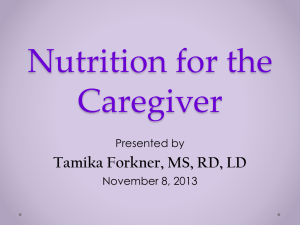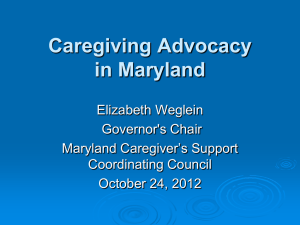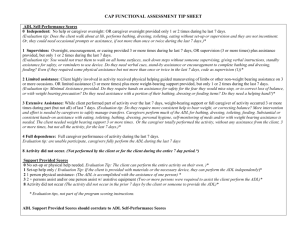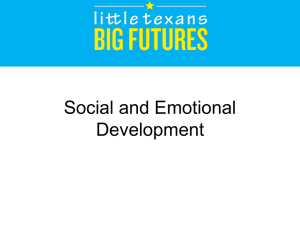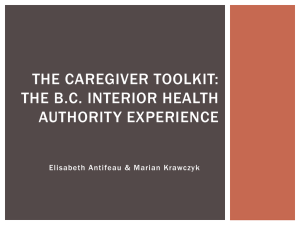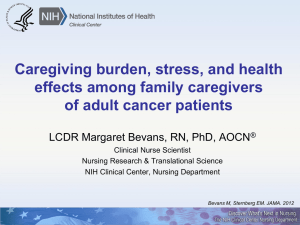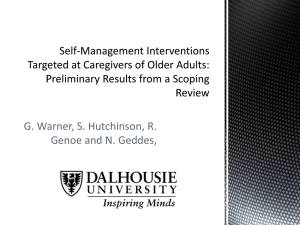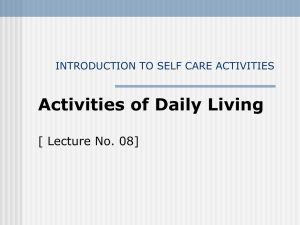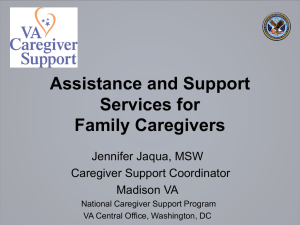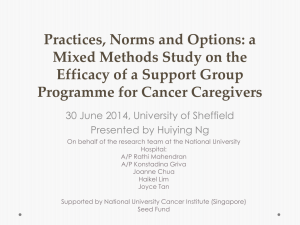View File
advertisement
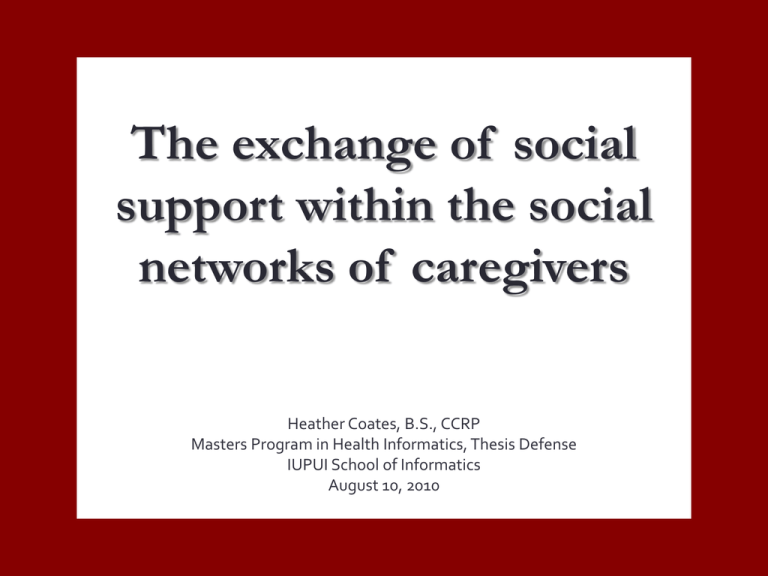
The exchange of social support within the social networks of caregivers Heather Coates, B.S., CCRP Masters Program in Health Informatics, Thesis Defense IUPUI School of Informatics August 10, 2010 Problem Statement • 16.8 million American caregivers for children with special needs • Prevalence of ASD in the US averages to 1 in 110 children • Cost of providing care for a child with special needs ranges from 2.5-20 times that of a typical child • Caregiver burden – physical, mental/ emotional, social • Families at risk for reduced ability to provide care due to caregiver burden • Social support may be a mediator for the effects of caregiver burden The aim of this study was to explore the relationships between the functional (i.e., four dimensions of social support) and the structural (i.e., ties and density) characteristics of the social networks of mothers providing care for children who have been diagnosed with one of the three Autism Spectrum Disorders, with the ultimate goal of developing interventions and services that meet their particular health information needs. 1. Capture and describe the basic features/characteristics of their social network structure. 2. What types of social support are embedded within these social networks? 3. What relationships exist between participant demographics and social support? 4. What relationships exist between participant demographics and the structural characteristics of the network? 5. What relationships exist between the provision of specific types of social support and the structural characteristics of the network? BACKGROUND Care recipients National Alliance for Caregiving, 2009 Caregiving Activities • • • • • • Caregiver Burden • • • • Physical Mental/emotional Social Financial Feeding (ADL) Getting dressed (ADL) Bathing (ADL) Getting into/out of seat (ADL) Transportation Coordination of therapies Needs • • • • • • Food Clothing Shelter Education Treatment & Therapies Socialization Social Support • Four dimensions – Appraisal – Emotional – Informational – Instrumental • Many standardized measures – Perception of quality Caregiving Activities • • • • • • Caregiver Burden • • • • Physical Mental/emotional Social Financial Feeding (ADL) Getting dressed (ADL) Bathing (ADL) Getting into/out of seat (ADL) Transportation Coordination of therapies Social Support • • • • Appraisal Emotional Informational Instrumental Needs • • • • • • Food Clothing Shelter Education Treatment & Therapies Socialization “A stable and supportive social network improves health outcomes for people with a wide range of conditions from heart failure to post-partum depression.” Sarasohn-Kahn, 2008 RESEARCH DESIGN Population & Sample • Mothers providing care for one or more children diagnosed with an Autism Spectrum Disorder • Convenience sample of Indiana residents • Recruited via two email distribution lists including approximately 1,500 parents Interview • 60-90 minute interview (07/09-12/09) • Semi-structured – Qualitative analysis (Content analysis) • Health challenges within past 6 months • Related information seeking strategies and resources – Quantitative analysis • Demographics: participant & child characteristics • Technology access & use • Social network structure & function Online survey • 20-25 minute survey (01/10-02/10) • Quantitative data – Demographics (including technology) • Participant & child characteristics – Social network structure – Social support (social network function) RESULTS Participant response Demographics n = 52 Social network questions n = 17 Social support questions n = 17 Who were the participants? • • • • • • Aged 35-44 Some college education (all completed HS) Married Employed full- or part-time Caucasian, non-Hispanic Living in Central Indiana Technology access & use • • • • All had home computers with internet 83% use the internet (browsers) daily Connect via some type of broadband 44% use the internet (browsers) 1-7 hours per week • 31% use the internet (browsers) 8-14 hours per week Research Question 1: Characteristics of network structure • wide range of network sizes (3-11) • density of respondents’ networks is relatively low • ties are generally multiplex • most participants use at least three technologies to communicate with members Research Question 2: social support in networks • caregivers engage in sharing informational support more than they receive it • appraisal support (advice) is the least prevalent dimension • all dimensions of social support are embedded Mean Standard Deviation Get info 2.76 2.33 Share info 4.94 2.86 Advice (appraisal) 3.12 2.74 Emotional 4.47 2.98 Assistance (instrumental) 3.65 2.52 Average number of connections for dimensions of social support Research Question 3: demographics and social support • Child age (significant for all dimensions and social support as a whole) • Age of diagnosis (significant for receiving info, emotional support, advice, and social support as a whole) Research Question 4: demographics & network structure • Correlations – Participant age (association) – Age of diagnosis (correlation) – Time spent on internet (Texting network) • Associations – Education – Employment – Child age – Age of diagnosis Research Question 5: network structure & network function • Correlations – Network size (all positive) • Instrumental support with email, telephone, f2f, SNS and whole networks • Emotional support with email and SNS networks • Sharing information with f2f, telephone, and whole networks • Social support as a whole with email, f2f, and whole networks – Network density • Assistance with SNS network • Emotional support with email network CONCLUSIONS Evaluating the evidence Strengths Limitations • Examines an understudied population • Information in context – as one piece of social support • Child & caregiver characteristics • Suggests characteristics for use in predictive models • • • • • Small sample size Convenience sample Typographical error in survey Missing data (non-responders) Limited social network data – Roles – Proximity • Limited characterization of networks Caregiving Activities • • • • • • Caregiver Burden • • • • Physical Mental/emotional Social Financial Feeding (ADL) Getting dressed (ADL) Bathing (ADL) Getting into/out of seat (ADL) Transportation Coordination of therapies Social Support • • • • Appraisal Emotional Informational Instrumental Needs • • • • • • Food Clothing Shelter Education Treatment & Therapies Socialization Future Research • Social network data for actor role, proximity, frequency of interactions • Parent report of child needs (ADLs) • Perceptions of caregiver burden • Longitudinal study – Child-caregiver networks – Caregiver social support networks – Child & caregiver social networks Agneessens, F., Waege, H., & Lievens, J. (2006). Diversity in social support by role relations: A typology. Social Networks, 28, 427-441. Ashida, S., & Heaney, C. A. (2008). Differential associations of social support and social connectedness with structural features of social networks and the health status of older adults. Journal of Aging and Health, 20(7), 872893. Hampton, K. N., Sessions, L. F., & Her, E. J. (2009). Social Isolation and New Technology - How the internet and mobile phones impact Americans ’ social networks. Retrieved from http://pewinternet.org/Reports/2009/18-Social-Isolation-and-New-Technology.aspx. Lin, C. H. (2009). Exploring facets of a social network to explicate the status of social support and its effects on stress. Social Behavior and Personality, 37(5), 701-710. National Alliance for Caregiving. (2009). Caregivers of children: A focused look at those caring for a child with special needs under the age of 18 Caregiving in the U.S. 2009. Bethesda, MD: National Alliance for Caregiving. Phillips, A. C., Gallagher, S., Hunt, K., Der, G., & Carroll, D. (2009). Symptoms of depression in non-routine caregivers: The role of caregiver strain and burden. British Journal of Clinical Psychology, 48, 335-346. Sarasohn-Kahn, J. (2008). The wisdom of patients: Health care meets online social media ihealthreports. Oakland, CA: California HealthCare Foundation. Tadema, A. C., & Vlaskamp, C. (2009). The time and effort in taking care for children with profound intellectual and multiple disabilities: A study on care load and support. British Journal of Learning Disabilities, 38, 41-48. Tsai, S.-M., & Wang, H.-H. (2009). The relationship between caregiver's strain and social support among mothers with intellectually disabled children. Journal of Clinical Nursing, 18, 539-548. Wasserman, S., & Faust, K. (1994). Social Network Analysis: Methods and Applications. Cambridge: Cambridge University Press.

